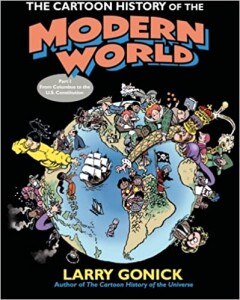 Harvard mathematician Larry Gonick continues his wildly successful Cartoon History of the Universe series with this book, an irreverent cartoon look at world history “From Columbus to the U.S. Constitution.” Anyone who loves history, comics or both should have this volume. I bought Gonick’s first Cartoon History of the Universe volume for one of my daughters when she was in middle school, and she remains a lover of history, particularly the unexpurgated kind Gonick puts forth.
Harvard mathematician Larry Gonick continues his wildly successful Cartoon History of the Universe series with this book, an irreverent cartoon look at world history “From Columbus to the U.S. Constitution.” Anyone who loves history, comics or both should have this volume. I bought Gonick’s first Cartoon History of the Universe volume for one of my daughters when she was in middle school, and she remains a lover of history, particularly the unexpurgated kind Gonick puts forth.
Gonick writes history in a very straightforward style with a populist slant. Here’s an example from the introduction to this book’s Volume 2, “What Goes Around”:
By 1492, the Kingdom of Portugal had explored West Africa for 50 years. The Portuguese had forts, plantations, trading posts, and allies in Africa. In 1488, a Portuguese ship rounded Africa’s tip and glimpsed a sea route to the Indies. So. . . when Columbus reached the Indies first (or so he said) and claimed them for Spain, Portugal felt cheated!
It being a cartoon book, this panel shows a couple of tiny castles on the Iberian peninsula, one saying “NO FAIR!!” and the other saying, “Oh, don’t get your Indies in a twist.”
It’s that kind of pointed writing and wordplay combined with mildly bawdy humor that makes it so appealing, particularly to the young and young at heart. In a later chapter on the adventures of the English, we find out that: “In 1585, some English landed on a beach north of Florida and called it Virginia after the queen’s sexual inexperience.” We see a line of people coming up the beach, luggage in hand; the man at the head of the line says to the women next to him, “Think what we’d have to call it if Henry VIII were still king. . .” to which she replies, “Fall?”
This volume actually begins with what was happing in America, pre-Columbus. And in between the major trends of European history, touches on what’s going on in India and China as well. In fact, one of the book’s major themes is the first-ever development of a global trading and communication network that was established in this era.
At the beginnings and ends of some chapters and in footnotes (designated by a foot holding a pen, drawing a musical eighth-note) the author’s persona shows up. He looks like a modern Einstein, wearing jacket and tie, his round moustachioed face framed by a halo of unruly dark hair.
Like many historians, Gonick likes to draw parallels between historic events and today’s news. I’m not sure how I feel about that in this case. It seemed to intrude sometimes, and I’m not sure some of the humorous barbs toward current world leaders will be meaningful to someone who reads this, say, 10 years from now. But I could be wrongly understimating Gonick’s readers, present and future.
But that’s my only quibble, and it’s a minor one. Gonick’s books make learning fun, and at the same time, the use of comic art to tell an often grisly and horrific tale can make the historian’s point better than any ponderous pontificating. That’s what makes these books so subversive, which any good history is, or should be.
(Collins, 2007)
